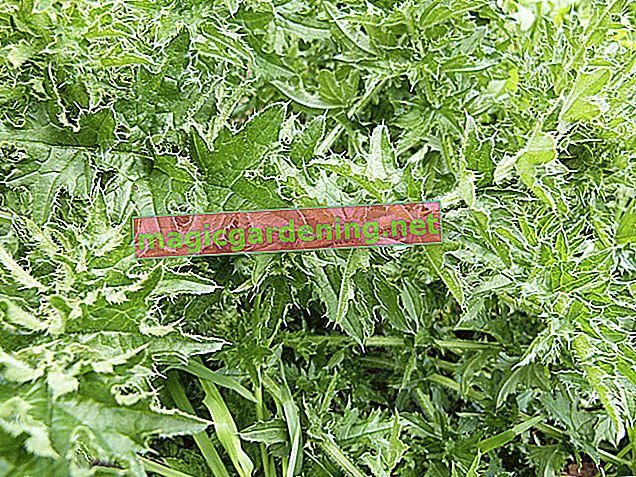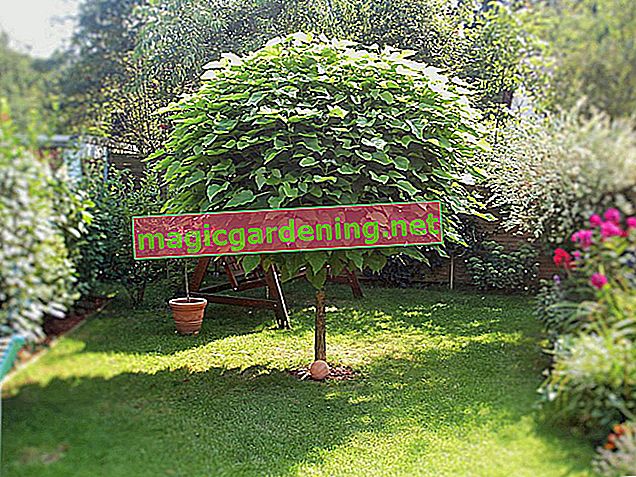
Tip 1: remove lawn weeds manually - this is how it works
Using the classic weeding method, you remove unwanted growth from the lawn by hand. In the early stages of infestation, this effort can prove to be quite effective in permanently removing lawn weeds. First and foremost, it is the annual seed weeds that are to be destroyed in this way. You can remove perennial root weeds such as brown elk or buttercups as follows:
- Ideally, a downpour has softened the lawn
- Reach deep into the earth with a weed picker to grasp the plant, including its roots and runners
- Shake the device back and forth a little and pull the lawn weeds out of the ground
also read
- Fighting plantain in the lawn - How to remove the weeds with success
- The 5 best tips against clover in the lawn
- Fighting weeds in the lawn - tips for correct scarifying
The weed cutter is designed so that no pieces of roots remain in the ground. The plants are able to sprout again even from tiny remains.
The most common lawn weeds
By definition, nearly 1,000 plant species are assigned to weeds. The following table shows which species are particularly prominent as lawn weeds:
| Annual lawn weeds | Perennial lawn weeds | Lawn moss |
|---|---|---|
| Chickweed (Stellasia media) | Dandelion (Taraxacum officinale) | Silver pear moss (Bryum argenteum) |
| Middle plantain (Plantago media) | Little dock (Rumex acetosella) | Chunky Wrinkle Brother (Rhytidiadelphus squarrosus) |
| Millet / chicken millet (Echinochloa) | Creeping Gunsel (Ajuga reptans) | Moss (Muscopsida) |
| White clover (Trifolium repens) | Little brown elk (Prunella vulgaris) | Liverworts (Hepaticopsida) |
| Thread speedwell (veronica filiformis) | Creeping buttercup (Ranunculus repens) | Hornworts (Anthocerotopsida) |
| Daisies (Bellis perennis) | Ragwort (Senecio vulgaris) | Peat moss (Sphagnidae) |
| Message (Atriplex micrantha) | Wood sorrel (Lotus corniculatus) | |
| White goosefoot (Chenopodium album) | Common horn clover (Lotus corniculatus) |
Tip 2: remove weeds mechanically from the lawn
If lawn weeds are already widespread mischief, manual control methods are limited. In order to free the stressed green area from weeds, you can get help from a scarifier. This is a special device that combs out clover, moss and other weeds with its knives. How to do it:
- Mow the lawn to a height of 2 cm
- Scarify the area lengthways and crossways
- Carefully remove and dispose of the combed out weeds
- After a waiting period of 7-14 days, fertilize the lawn and sprinkle it repeatedly
Tip 3: Kill lawn weeds with foil
On smaller pieces of lawn, you can destroy weeds without any physical effort or mechanical support using a black plastic sheet. This acts as an effective remedy against weeds because it interrupts the supply of light. Photosynthesis does not take place where the sun's rays cannot reach, and thus no growth.
The tarpaulin is fixed with stones, sand or plastic anchors. After a waiting period of 2-3 months, the lawn weeds died. The grass, on the other hand, will recover quickly, as part of professional lawn care. It is even quicker to reseed a type of lawn that is suitable for the location.
Tip 4: Use chemical pesticides against weeds in the lawn
If you are confronted with tough weeds in your lawn, manual and mechanical techniques will not work. If you don't want to decide on a new plant and don't want to turn the lawn into a wildflower meadow, you cannot avoid using a chemical weed killer. The following sprays are approved for the home garden and have proven themselves well:
- Bayer Garten universal lawn weed-free
- Anicon Ultra lawn weed-free from Celaflor
- Compo lawn weed killer Perfect
- Lawn Weed Free Plus from Neudorff
- Banvel M lawn weed killer
In order for these weed killers to develop their full potential, spray them preferably when used in mild, dry weather. Ideally, the lawn was fertilized 14 days beforehand, because sprays work through the leaf mass. We therefore recommend not to mow the lawn in the days before.
Tip 5: A double pack against lawn weeds - this is how it works
With a combination product of weed killer and fertilizer, you can grapple with lawn weeds. While the contained agent is active against weeds, the grasses are supplied with nutrients over a period of 100 days. In this way you not only free the green area from annoying growths, but also transform it into the longed-for lush green carpet.
- Beckmann Premium lawn fertilizer with weed killer
- Compo UV lawn Floranid
- Substral lawn fertilizer with weed killer
- Stretch weed killer plus lawn fertilizer
- Floranid lawn fertilizer against weeds and moss
- Manna Dur UV weed killer with lawn fertilizer
To achieve the desired result, the lawn is first mowed and scarified. Then distribute the combi-agent against weeds with the spreader and water with the lawn sprinkler. (€ 27.94 at Amazon *) It is only mowed again when no more fertilizer grains can be seen.
Tip 6: This is how lime works as an effective weed killer
A perfectly manicured lawn has a pH value between 6 and 7. If this value falls below 5.5, the soil acidity drifts into the acidic range. Most weeds and mosses thrive in such soil. You should therefore first test the pH value in a weed lawn using a test kit from the hardware store. According to the results, the lawn is limed carefully.
So that the lawn can process the lime as well as possible, it is scarified in advance if possible. If the administration of fertilizer is planned, there should be an interval of 3-4 weeks between the two preparations. Do not spray any weed agents during this time, as otherwise an incalculable accumulation of the active ingredients could set in and damage the lawn.
If you are confronted with lime-loving weeds such as horn clover, we strongly advise against liming. Since the pH value in this case is likely to be above 7 anyway, lime is now counterproductive.
Tip 7: Remove weeds from lawns using natural means
In the natural garden, home remedies are the trump card. Environmentally conscious hobby gardeners are therefore always on the lookout for a natural remedy for weeds, beyond back pain from weeding, expensive rental fees for scarifiers (€ 76.01 at Amazon *) and the chemical club. With a great deal of perseverance, here's how you remove lawn weeds:
- Sprinkle dandelions repeatedly with pure charcoal ash in autumn
- Seed weeds, such as couch grass, never bloom by plucking them out consistently
- Water root weeds with boiling water, pull out the dead part and water again
- Cut thistles just before a downpour so that the stems will rot afterwards
Tips
A traditional home remedy for weed killing is frowned upon today. In grandfather's time, vinegar and salt were used as sprays on paths and surfaces. However, the two active ingredients in combination destroy all life in the soil. In the new version of the Plant Protection Act of 2012, spraying vinegar and salt is forbidden and is punishable with heavy fines if not observed.
Tip 8: Professional mowing as a remedy for weeds - this is how it works
Used correctly, the lawn mower serves as a powerful remedy against weeds. Lawn weeds rely on a sufficient amount of light to germinate. Do not mow deeper than 4 centimeters. At this cutting height, weed seeds are permanently shaded by the grass, which prevents germination.
In order to remove weeds from the lawn, it should be mowed as regularly as possible every 7 days. In the long run, the undesirable growths weaken and ultimately withdraw. In addition, dedicate adequate care to the green area so that no new weeds gain a foothold. A balanced water and nutrient balance are just as important as annual scarifying and ventilation.
Tip 9: Suppress weeds in the lawn with turbo overseeding
Various weed remedies leave more or less large bald spots and holes in the lawn. Over-sowing with a turbo effect counteracts cunning lawn weeds here again immediately. For this purpose, specialist dealers offer products that consist of special lawn soil and rapidly germinating lawn seeds.
The gaps or bumps are filled with the agent, rolled and then watered. In the period that followed, the new lawn flourishes so quickly that weed seeds that fly on have no chance of germination.
Tip 10: Rolled turf sandwich method as the final weed kill
If a lawn is only vaguely reminiscent of a green carpet, creative hobby gardeners use the turf sandwich method. Within a day, the garden is adorned with a velvety showcase lawn, completely without weeds. This is how it works:
- Mow the weed-covered lawn as short as possible
- Level out any unevenness with a mix of compost and sand or topsoil
- Lay the freshly delivered lawn rolls butt to edge and offset
- Finally, roll the new lawn lengthways and crossways and water it thoroughly
The thick sod of the rolled turf reliably prevents the weeds underneath from fighting their way to the surface.
Tips & Tricks
While mulch promotes weed growth on the lawn, lawn clippings themselves serve as an effective mulch material in the bed. However, fresh clippings should not be used. Simply let it wither in a corner of the garden and spread it as thick as a finger in the kitchen garden or the perennial bed. In this way weeds are suppressed, the soil remains moist longer and is supplied with additional nutrients.








